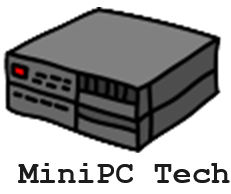What Can a Raspberry Pi Firewall do for your Home Network?
Protect your home network with a Raspberry Pi firewall by setting it up for traffic management and unauthorized access prevention. Start by updating your Pi, installing firewall software like UFW or IPTables, and configuring rules to block unwanted connections. Enable features like SSH for secure access while ensuring that only necessary ports are open. Regularly monitor traffic and maintain your firewall to address new threats effectively. You’ll discover more useful home security strategies as you explore the possibilities of Raspberry Pi network projects.
Key Takeaways
- Set up a Raspberry Pi firewall using tools like UFW for user-friendly management of traffic rules and enhanced security against unauthorized access.
- Regularly update and review firewall rules to ensure only necessary access is allowed, adhering to the principle of least privilege.
- Enable remote access for services such as SSH while restricting unwanted connections through port blocking and IP filtering techniques.
- Monitor network traffic with tools like Wireshark and Tcpdump for real-time analysis, identifying unauthorized access attempts and anomalies.
- Implement additional security features like fail2ban for protecting against brute-force attacks and maintain strong access controls for better network safety.
Setting Up Your Raspberry Pi for Firewall Use
To set up your Raspberry Pi firewall, you’ll first need to prepare the device for peak performance.
Begin by updating the package list with ‘sudo apt update’, then upgrade existing packages using ‘sudo apt upgrade’. This guarantees your system’s resources are optimized for network configuration tasks. Firewalls serve as security barriers between internal networks and external networks, which is essential for protecting your Raspberry Pi. Additionally, setting up a Raspberry Pi as a firewall can provide essential network security features that help defend against various cyber threats.
Next, install necessary tools like ‘iptables’ or ‘ufw’ to manage firewall benefits. Confirm a stable internet connection for package downloads, and backup critical data to avoid troubleshooting issues later.
Implement security best practices by managing user permissions diligently.
After preparing the Pi, you’ll be ready to install the selected firewall software and configure it for your home network’s security needs, enhancing protection against unauthorized access.
Choosing the Right Firewall Software
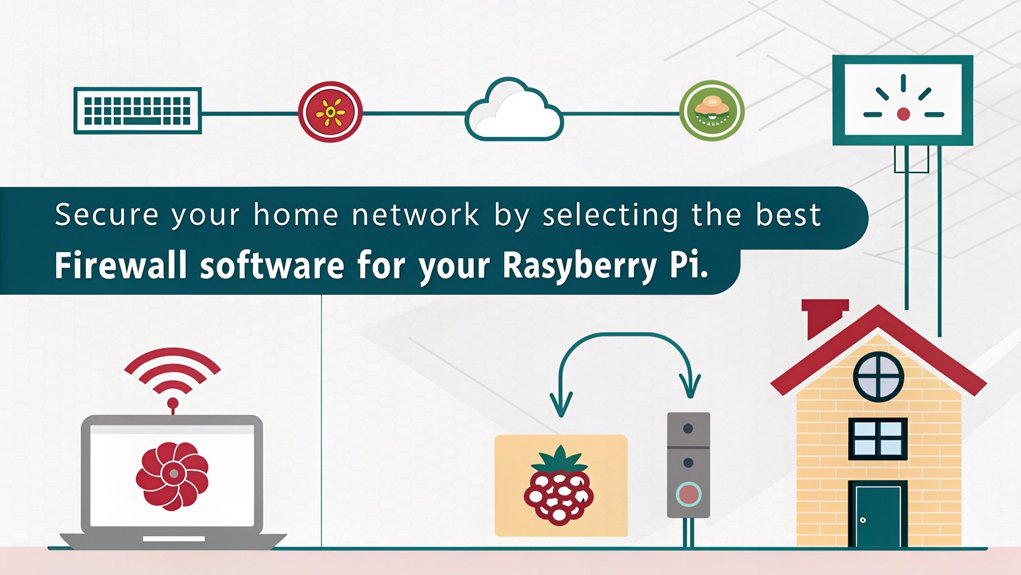
When choosing firewall software for your Raspberry Pi, you need to evaluate key features such as ease of use, customization options, and security capabilities. Firewalls act as barriers regulating traffic in/out of networks, which is essential for protecting your home network. Consider how each option aligns with your technical skills and the specific needs of your home network. Balancing functionality with user experience will help you make an informed decision. Additionally, selecting software that offers packet filtering will enhance your ability to monitor and control traffic effectively.
Key Features Comparison
Choosing the right firewall software for your Raspberry Pi can greatly impact your home network’s security and performance. IPFire offers high customization, an intuitive web interface, and supports various protocols, making it a solid choice for tailored security needs. Furthermore, the performance variations from models tested indicate that the choice of firewall software should also consider the capabilities of your Raspberry Pi’s hardware.
IPTables, built into Raspberry Pi OS, provides powerful packet filtering with extensive documentation for precise control but lacks a user-friendly interface. Additionally, it leverages the size of the Raspberry Pi to perform efficiently in limited hardware environments. OpenWrt transforms your Pi into a robust firewall router, with various configuration options and the ability to manage malware effectively.
Firewalld, known for its superior user interface design, simplifies rule management while supporting different firewall zones. Evaluate firewall performance metrics for each option to guarantee the best fit for your network’s requirements and capabilities.
User Experience Considerations
While different firewall options exist, user experience should be a critical factor in selecting the right software for your Raspberry Pi.
For advanced users, IPTables offers extensive customization but requires significant technical expertise for setup. In contrast, OpenWrt provides a thorough solution with a user-friendly interface, enabling easy configuration and advanced features like VPN support and QoS.
If you prefer simplicity, UFW streamlines firewall usability with its intuitive management of IPTables, making it easy to set up precise rules. Firewalld also enhances user experience by simplifying Netfilter/IPTables management while integrating well with other network services. Raspberry Pi can be transformed into an effective firewall to protect your home network through careful software selection.
Consider your technical proficiency and desired features to guarantee you choose the firewall software that aligns with your user experience needs.
Configuring Firewall Rules for Your Network

To effectively configure your firewall, you’ll need to allow essential services while blocking unwanted connections.
Start by implementing default policies that deny all inbound traffic and allow outbound traffic. This approach establishes a strong security baseline, ensuring only the necessary data flows in and out of your network. Regular reviews of firewall policy are necessary to adapt to changing threats and maintain optimal protection. Additionally, consider the performance limitations of Raspberry Pi models, as they affect the effectiveness of your firewall setup.
Allowing Essential Services
Establishing essential services on your Raspberry Pi’s firewall requires careful configuration of specific rules to guarantee smooth operation. Start by enabling remote access configurations for SSH by running ‘sudo ufw allow 22/tcp’, which permits secure command-line access. For remote desktop capabilities, allow VNC traffic on port 5900 with ‘sudo ufw allow 5900’. Ascertain your web server functions by permitting HTTP and HTTPS ports (80 and 443) using ‘sudo ufw allow 80’ and ‘sudo ufw allow 443’. Remember to specify the correct essential service protocols, like TCP, when defining your rules.
Additionally, ensure the use of a local firewall to prevent unauthorized connections from potentially exposing your devices. Be mindful that default settings can allow unwanted traffic if specific rules are not established. After configuring, verify the implementation with ‘sudo ufw status’ to confirm that your firewall correctly reflects these essential service permissions for seamless networking.
Blocking Unwanted Connections
After allowing access to necessary services, your next step is to block unwanted connections that could jeopardize your network’s security. Using port blocking and IP filtering techniques, you can effectively restrict access. It is essential to consider that both UFW and firewalld provide user-friendly firewall management options for configuring your rules easily. Additionally, leveraging OpenWrt’s low space requirements allows for efficient use of resources when managing firewall settings.
Regularly reviewing and updating your firewall rules is crucial, as it aligns with the principle of least privilege, ensuring only necessary access is granted. This practice also helps mitigate risks associated with unpatched software, which is a common gateway for cyber threats.
| Action | Command | Description |
|---|---|---|
| Block a specific port | ‘sudo ufw deny [PORT]’ | Denies access to a designated port |
| Block from a specific IP | ‘sudo ufw deny from [IP] to any port’ | Limits access from untrusted IPs |
| Block a range of ports | ‘sudo ufw deny [PORT-range]’ | Denies access to multiple ports |
Regularly review and update your rules with ‘sudo ufw status’. Combine options for precision, maintaining robust network security over time. This guarantees you’re always one step ahead of potential threats.
Implementing Default Policies
Implementing default policies is crucial for shaping your firewall’s behavior, as it determines how your Raspberry Pi handles traffic by default. You can choose between ALLOW and DENY modes, greatly impacting default policy implications. In ALLOW mode, all outgoing traffic passes, but only responses to initiated connections are accepted. Conversely, DENY mode blocks all traffic unless explicitly allowed, which could disrupt access if no rules are configured. Effective firewall configuration strategies involve setting these policies using simple commands like ‘sudo ufw default allow incoming’ or ‘sudo ufw default deny incoming.’
Additionally, it is important to note that Cloud Firewalls can also allow or block traffic based on predefined inbound and outbound rules, enhancing your overall security posture. UFW provides a user-friendly interface to manage these settings easily, enhancing your overall security posture.
Implementing Advanced Security Features
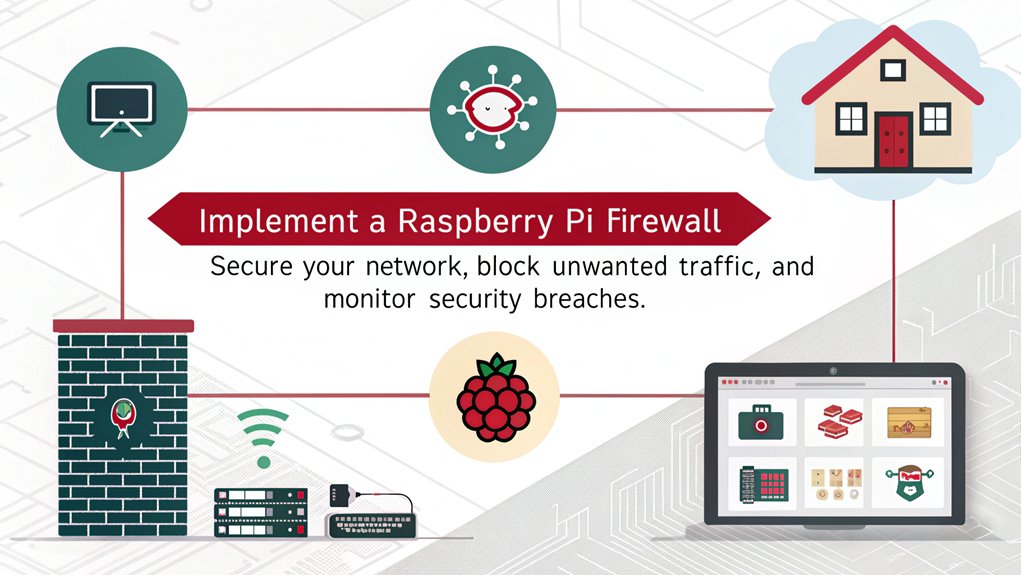
To bolster your home network security, you’ll want to implement advanced features on your Raspberry Pi firewall. Start by installing UFW and configuring firewall rules with commands like ‘sudo ufw allow 80/tcp’ for basic traffic management. Additionally, consider creating a new user to replace the default user, as this is an essential security measure for Raspberry Pi.
For more intricate needs, employ ‘iptables’ for advanced packet filtering, allowing traffic from specific IPs while blocking others. Integrate tools like ‘fail2ban’ to enhance your intrusion prevention capabilities, effectively mitigating brute-force attacks. Ensuring the integrity of your boot process with Secure Boot can further protect against unauthorized access and malware.
Additionally, segment your network to isolate IoT devices, ensuring tighter control over sensitive areas. Monitor traffic between segments using OpenWrt, applying Quality of Service settings for prioritization.
Protecting Your Home Network From Threats
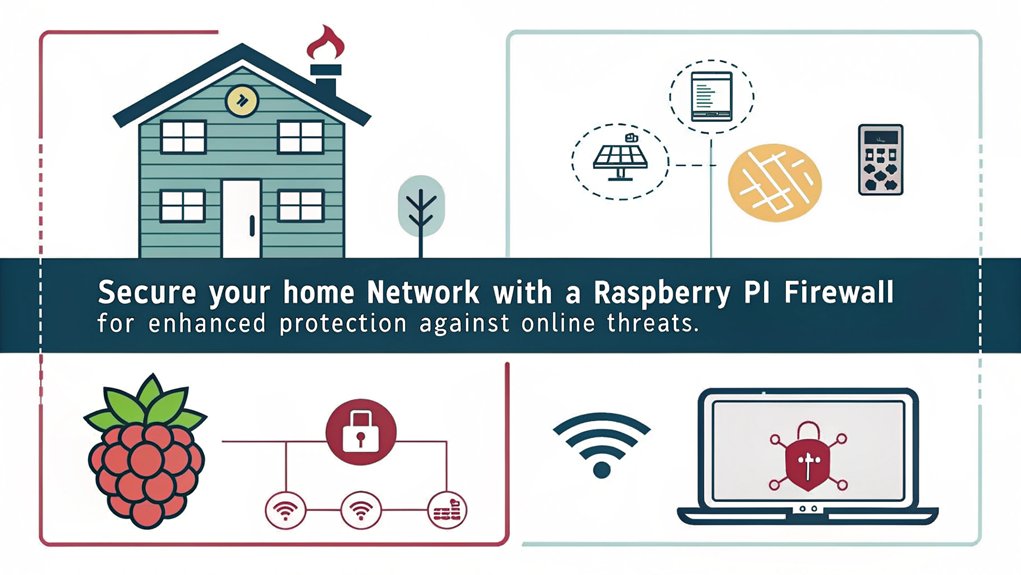
With the rise of connected devices in homes, understanding how to defend your network from a variety of threats is essential. You need to cultivate threat awareness, particularly regarding network vulnerabilities. The alarming statistics highlight the urgency of your vigilance:
- Home networks face an average of 10 attacks daily.
- IoT devices often fall prey to automated attacks.
- Many connected devices are incapable of running security software and lack secure boot mechanisms to prevent unauthorized code execution.
- Common threats include phishing, malware, and DoS attacks. Additionally, 67% of home computer networks are affected by at least one cybersecurity threat monthly, emphasizing the importance of proactive measures. Implementing tools like NMAP and Wireshark can help identify vulnerabilities and monitor network traffic effectively.
Monitoring Traffic and Maintaining Security

As you monitor your network traffic, using the right tools and configurations can help you maintain security effectively. Leverage tools like Wireshark for real-time traffic analysis, setting up filters to focus on specific data types. Tcpdump can aid in packet analysis, enabling you to capture and inspect TCP/IP traffic efficiently. Implementing a Raspberry Pi for network monitoring allows for cost-effective and efficient oversight of your home network security. Additionally, integrating tools like Bashtop resource monitor can provide real-time visualization of your network data usage.
Ensure your setup includes energy-efficient components, such as SSDs, to reduce power consumption and heat generation. It is also crucial to implement strong access controls, including role-based access control (RBAC), to ensure only authorized users have access to the Raspberry Pi firewall. Implement scripts to monitor for network anomalies and send alerts during unusual activity. Regularly analyze data through tools like Logwatch to identify patterns and simplify reporting. Keep your Raspberry Pi firewall updated to guarantee it handles high traffic without performance issues.
Additional Security Measures for Enhanced Protection
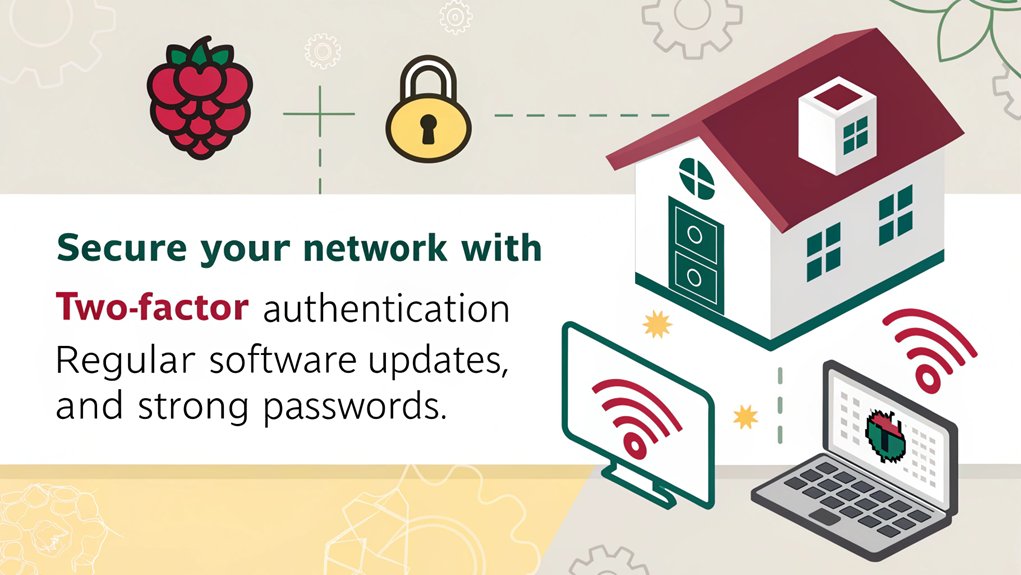
Monitoring your network traffic lays a solid foundation, but incorporating additional security measures further strengthens your defenses.
Implementing robust physical security and network isolation techniques guarantees that your Raspberry Pi firewall isn’t just a standalone solution.
Consider the following strategies:
- Use enclosures and locked cases to protect against unauthorized access.
- Create separate subnets for different devices, limiting malware spread.
- Utilize VLANs to segregate and control network traffic effectively.
- Set up a DMZ for public-facing services to shield your internal network.
- Ensure your setup includes regular software updates to patch vulnerabilities and enhance overall security.
- Consider investing in a UPS with Automatic Voltage Regulation to protect your Raspberry Pi from power anomalies and ensure continuous operation during outages.
These measures not only enhance your overall security posture but also create a formidable barrier against potential threats, guaranteeing your home network remains secure and resilient.
Tips for Ongoing Maintenance and Updates
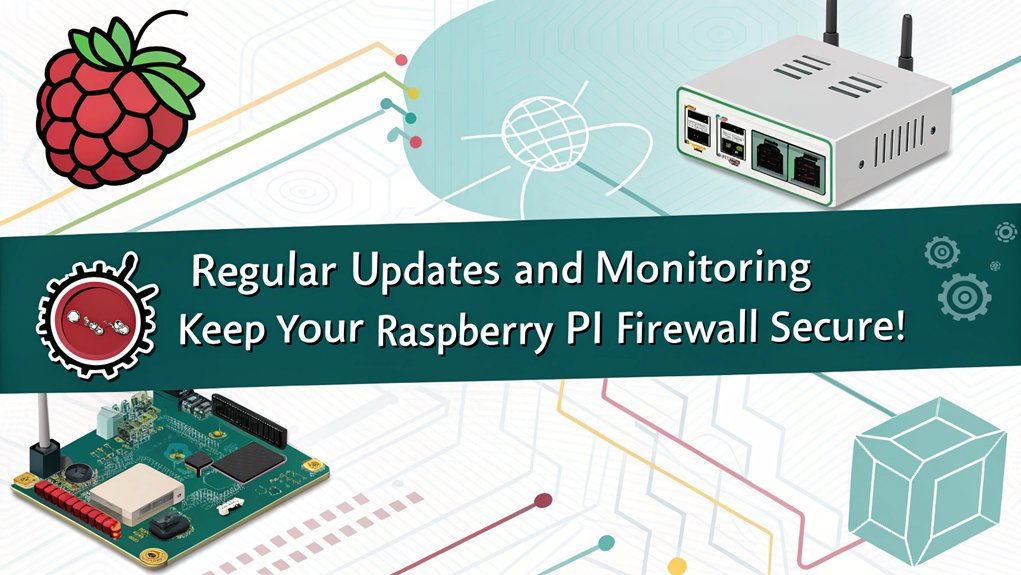
To guarantee your Raspberry Pi firewall remains effective over time, regular maintenance and updates are essential.
Start with software updates; run ‘sudo apt-get update’ and ‘sudo apt-get upgrade’ frequently. Don’t skip those critical security patches and kernel updates for enhanced system stability.
Next, review your firewall rules regularly. Check for unnecessary open ports and adjust your network security policy accordingly by using ‘sudo ufw status’.
Ensure your network settings are secure by configuring static IP configurations as needed, followed by a Raspberry Pi restart to apply changes.
Firewall testing is fundamental—perform routine checks to identify vulnerabilities and simulate attacks to confirm your firewall’s response.
Regularly inspect system logs for suspicious activity and change any default passwords to enhance security.
Exploring Additional Raspberry Pi Network Projects
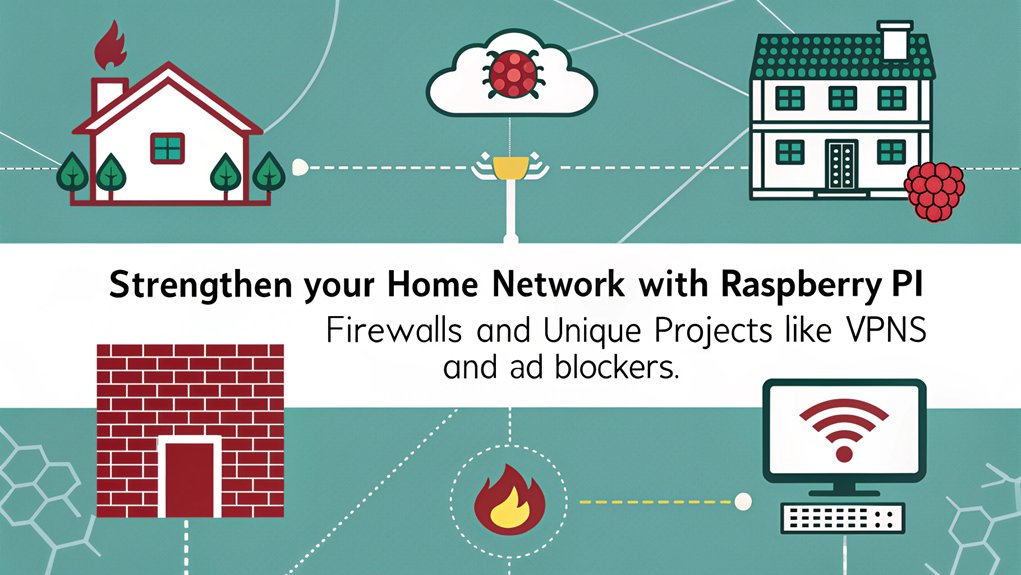
While a Raspberry Pi firewall is critical for securing your home network, it also offers a platform for exploring a variety of additional network projects.
By diving into these innovative Raspberry Pi projects, you can enhance your network automation capabilities:
- Home Assistant: Seamlessly manage smart devices through a web interface.
- VPN Server: Establish secure remote connections for enhanced privacy.
- File Storage Server: Create centralized storage accessible across devices, leveraging NextCloud for user-friendly interfaces and enhanced privacy features.
- Intrusion Detection System: Monitor and prevent unauthorized access in real time.
These projects not only bolster your network’s functionality but also empower you to take control of your connected environment. Additionally, mastering hardware integration techniques, such as those involving SPI and I2C protocols, is crucial for configuring peripherals effectively.
With each project, you’ll enhance both security and automation, paving the way for a smarter home network.
Frequently Asked Questions
Can I Use a Raspberry Pi as a VPN Server?
Yes, you can use a Raspberry Pi as a VPN server. Its benefits include easy setup, cost-effectiveness, and excellent privacy features. Choose between OpenVPN or WireGuard for superior performance during your VPN server setup.
What Type of Raspberry Pi Is Best for a Firewall?
For ideal firewall performance, you should choose the Raspberry Pi 4B. Its superior processing power and RAM capacity greatly enhance throughput and efficiency compared to earlier Raspberry Pi models, making it ideal for advanced network tasks.
How Do I Test My Raspberry Pi Firewall Configurations?
Your firewall’s configuration is essential—like a digital fortress. For effective firewall testing, perform configuration verification through audits, traffic simulations, and penetration tests. These practices enhance security, ensuring your defenses are as robust as they can be.
Can I Run Other Applications Alongside the Firewall?
Yes, you can run other applications alongside your firewall. Most firewalls guarantee excellent application compatibility and maintain solid firewall performance, allowing you to operate multiple services without significant resource consumption or conflicts in your network setup.
What Should I Do if My Firewall Blocks Legitimate Traffic?
If your firewall blocks legitimate traffic, consult the firewall logs for insights. Consider traffic whitelisting, adjusting rules to permit necessary connections while ensuring security. This balance fosters innovation without sacrificing protection against potential threats.
Conclusion
By implementing a Raspberry Pi firewall, you’re fortifying your home network like a castle’s moat, deterring unwanted intruders. With the right software, configurations, and ongoing maintenance, you can create a robust line of defense against online threats. Remember, your network’s security is a continuous journey—stay vigilant, monitor traffic, and adapt to emerging risks. Embracing these practices empowers you to protect your digital domain and enjoy peace of mind in an increasingly connected world.

I am a retired software engineer with experience in a multitude of areas including managing AWS and VMWare development environments. I bought a relative a mini-PC a year ago and have become passionate about the technology and its potential to change how we deploy software.
